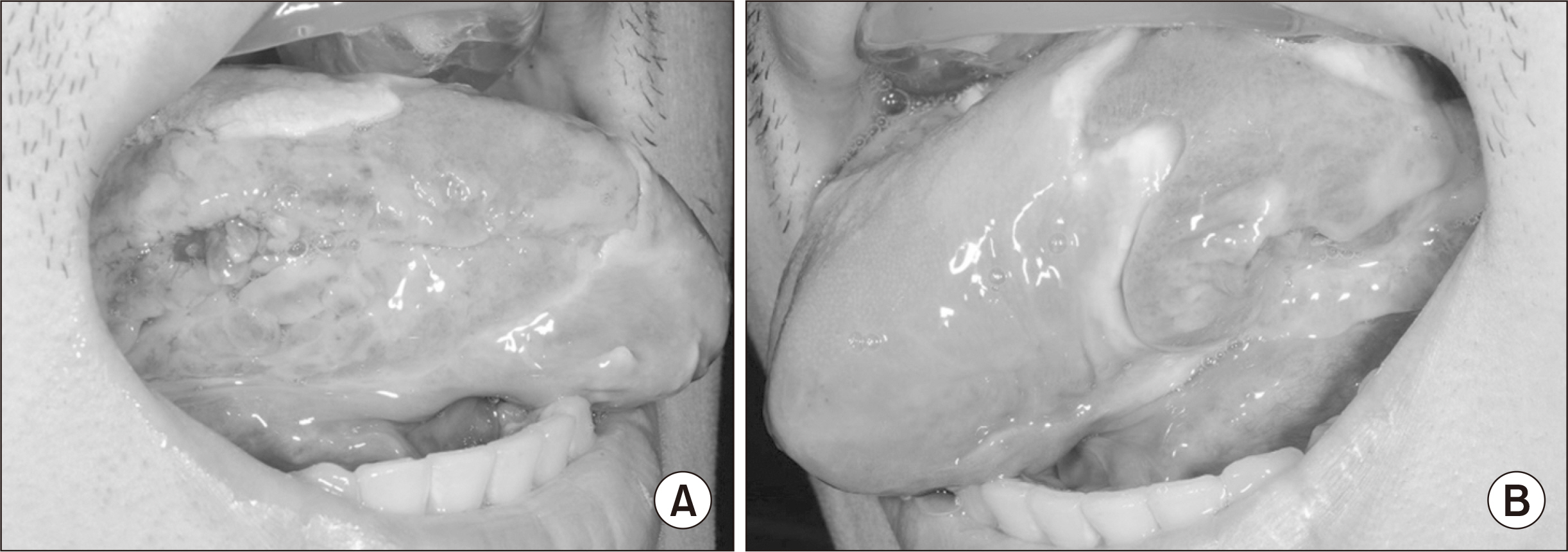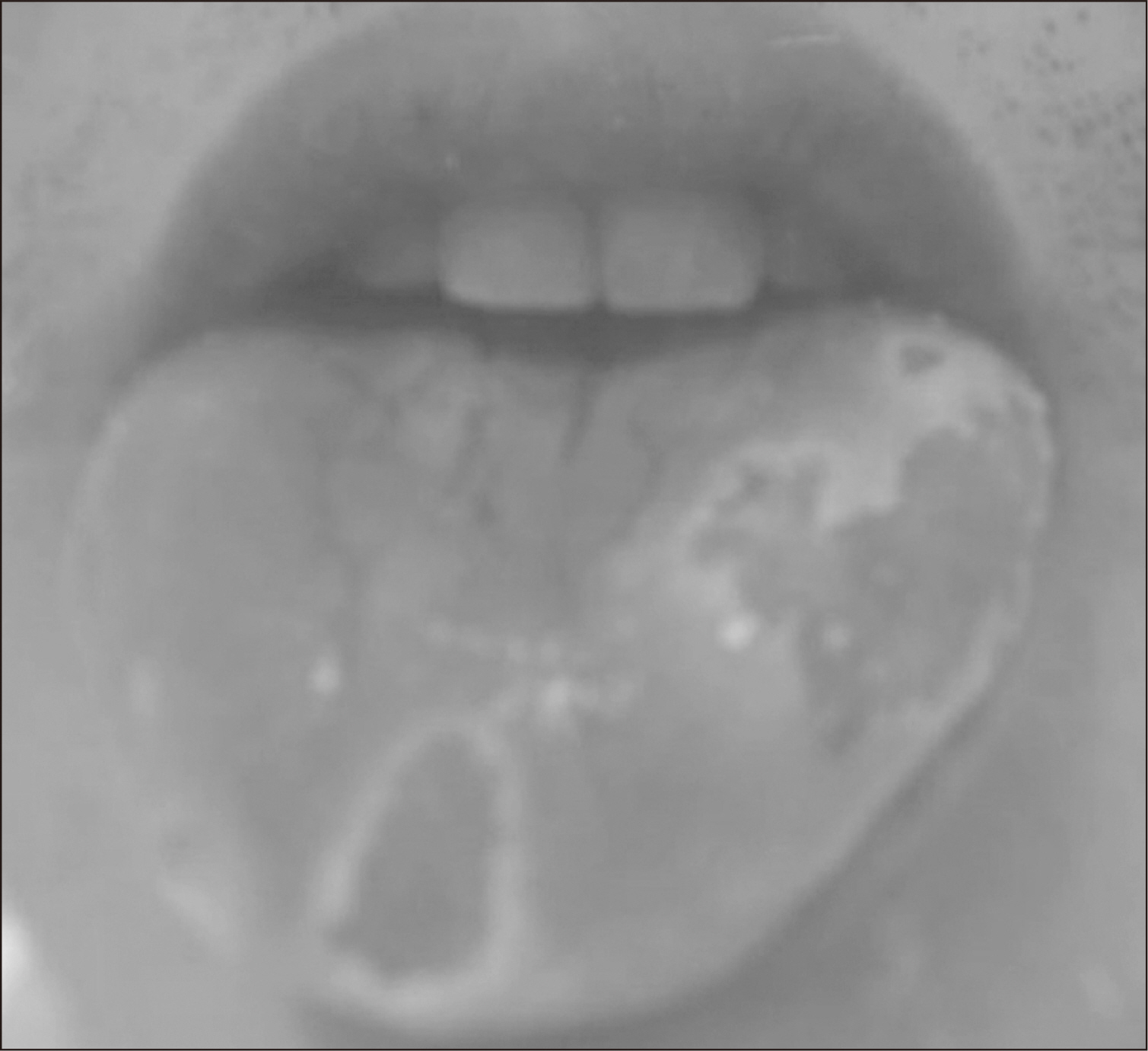J Korean Acad Oral Health.
2024 Sep;48(3):151-154. 10.11149/jkaoh.2024.48.3.151.
Traumatic ulcer in patient with obsessive-compulsive disorder: a case report
- Affiliations
-
- 1Department of Orofacial Pain and Oral Medicine, Dankook University Dental Hospital, Cheonan, Korea
- KMID: 2559885
- DOI: http://doi.org/10.11149/jkaoh.2024.48.3.151
Abstract
- Traumatic ulcers are common oral mucosal lesions primarily caused by mechanical trauma, typically presenting as solitary lesions with low recurrence rates. However, when associated with psychiatric disorders, these ulcers can become extensive and multiple. This study details a case of multiple traumatic ulcers in a 25-year-old male patient with obsessive-compulsive disorder focusing on characteristics and treatment process. Three months prior the patient began biting his tongue due to itching, leading to severe ulcers from uncontrollable repeated biting. Histopathological examination excluded reactive lesions, infectious diseases, and malignancies, confirming the diagnosis of a traumatic ulcer. Treatment included systemic and topical corticosteroids, behavioral modification therapy, and oral appliance use. Despite a significant reduction in ulcer severity, poor compliance with oral appliances resulted in incomplete healing and recurrence. This case highlights the impact of psychiatric disorders on the development and exacerbation of traumatic ulcers, underscoring the importance of proper diagnosis and treatment by dental professionals.
Figure
Reference
-
References
1. Mortazavi H, Safi Y, Baharvand M, Rahmani S. 2016; Diagnostic features of common oral ulcerative lesions: an updated decision tree. Int J Dent. 2016:7278925. DOI: 10.1155/2016/7278925. PMID: 27781066. PMCID: PMC5066016.2. Pérez MA, Raimondi AR, Itoiz ME. 2005; An experimental model to demonstrate the carcinogenic action of oral chronic traumatic ulcer. J Oral Pathol Med. 34:17–22. DOI: 10.1111/j.1600-0714.2004.00249.x. PMID: 15610402.3. Rosa DE, Hapid MH, Hidayat W. 2023; Non-healing chronic traumatic ulcer, an entity that can resemble other chronic ulcers. Int Med Case Rep J. 16:585–590. DOI: 10.2147/IMCRJ.S421748. PMID: 37779825. PMCID: PMC10540854.4. Lee ST, Jang SB, Kwon TG, Choi SY. 2019; Oral tuberculosis mimicking a traumatic denture ulcer. J Prosthet Dent. 121:225–228. DOI: 10.1016/j.prosdent.2018.04.024. PMID: 30722984.5. Leão JC, Gueiros LA, Porter SR. 2006; Oral manifestations of syphilis. Clinics (Sao Paulo). 61:161–616. DOI: 10.1590/S1807-59322006000200012. PMID: 16680334.6. Fonseca FP, Andrade BAB, Coletta RD, Vargas PA, Lopes MA, Almeida OP, et al. 2013; Clinicopathological and immunohistochemical analysis of 19 cases of oral eosinophilic ulcers. Oral Surg Oral Med Oral Pathol Oral Radiol. 115:532–540. DOI: 10.1016/j.oooo.2012.11.007. PMID: 23375504.7. Stein DJ, Costa DLC, Lochner C, Miguel EC, Reddy YCJ, Shavitt RG, et al. 2019; Obsessive-compulsive disorder. Nat Rev Dis Primers. 5:52. DOI: 10.1038/s41572-019-0102-3. PMID: 31371720. PMCID: PMC7370844.8. Lee SI, Kim YJ, Lee SH, Kim CC, Hahn SH, Jang KT. 2005; The dental management of self-inflicted oral mutilation. J Korean Acad Pediatr Dent. 32:244–250.9. Cannavale R, Itro A, Campisi G, Compilato D, Colella G. 2015; Oral self-injuries: Clinical findings in a series of 19 patients. Med Oral Patol Oral Cir Bucal. 20:e123–129. DOI: 10.4317/medoral.19643. PMID: 25475766. PMCID: PMC4393972.10. Limeres J, Feijoo JF, Baluja F, Seoane JM, Diniz M, Diz P. 2013; Oral self-injury: An update. Dent Traumatol. 29:8–14. DOI: 10.1111/j.1600-9657.2012.01121.x. PMID: 22340154.
- Full Text Links
- Actions
-
Cited
- CITED
-
- Close
- Share
- Similar articles
-
- Aripiprazole Improved Obsessive Compulsive Symptoms in Asperger's Disorder
- Obsessive-compulsive Disorder in a Patient with 47,XXX, Triple X Syndrome
- The form and content of obsessions and compulsions in the obsessive-compulsive disorder
- A Case Series of Post-traumatic Obsessive Compulsive Disorder: a Six Month Follow-up Evaluation
- New Onset Obsessive Compulsive Disorder Following High Frequency Repetitive Transcranial Magnetic Stimulation over Left Dorsolateral Prefrontal Cortex for Treatment of Negative Symptoms in a Patient with Schizophrenia




